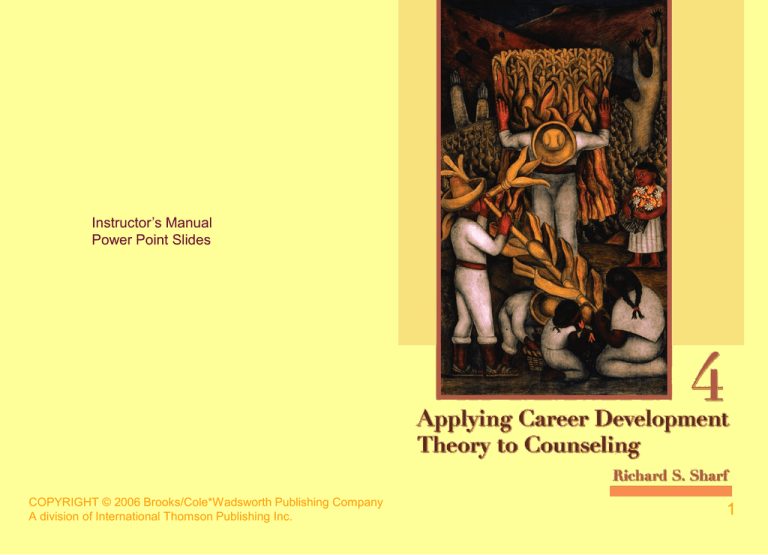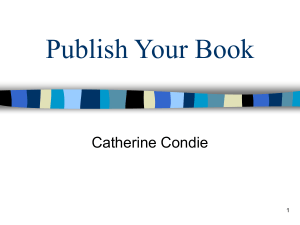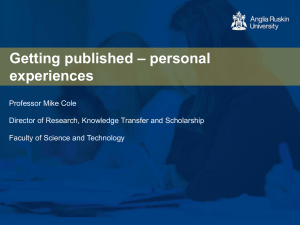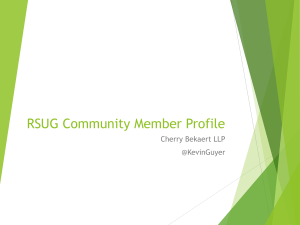
Instructor’s Manual
Power Point Slides
COPYRIGHT © 2006 Brooks/Cole*Wadsworth Publishing Company
A division of International Thomson Publishing Inc.
1
Slide 1 for Chapter 1
Definitions
Career
Career choice
Jobs
Occupations
COPYRIGHT © 2006 Brooks/Cole*Wadsworth Publishing Company
A division of International Thomson Publishing Inc.
2
Slide 2 for Chapter 1
Career and Personal Counseling
Career counseling includes personal issues
Personal counseling includes career issues
l
l
l
l
Goals may be explicit or implicit
COPYRIGHT © 2006 Brooks/Cole*Wadsworth Publishing Company
A division of International Thomson Publishing Inc.
3
Slide 3 for Chapter 1
Theory Development
Theories must be:
Explicit about rules and terms
Precise about predictions and limitations
Tested through research
Consistent and clear
COPYRIGHT © 2006 Brooks/Cole*Wadsworth Publishing Company
A division of International Thomson Publishing Inc.
4
Slide 4 for Chapter 1
Career Development Theory
To use career development theories, counselors should consider:
Their client populations
Their theory of personality and counseling
The theory’s ease of use in counseling sessions
COPYRIGHT © 2006 Brooks/Cole*Wadsworth Publishing Company
A division of International Thomson Publishing Inc.
5
Slide 5 for Chapter 1
A View of Psychology as a Science (Dawis)
Person
Environment
(Person - Environment Fit)
COPYRIGHT © 2006 Brooks/Cole*Wadsworth Publishing Company
A division of International Thomson Publishing Inc.
6
Slide 6 for Chapter 1
Career Counseling Skills
Helping skills
Knowledge of tests
Knowledge of occupational Information
Knowledge of career development theory
COPYRIGHT © 2006 Brooks/Cole*Wadsworth Publishing Company
A division of International Thomson Publishing Inc.
7
Slide 7 for Chapter 1
Helping Skills used in Career Counseling
Attending
Continuation responses
Questioning
Giving information not opinion
Reinforcement
Restating
Family background exploration
Reflecting content
Test and inventory
interpretation
Reflecting feelings
COPYRIGHT © 2006 Brooks/Cole*Wadsworth Publishing Company
A division of International Thomson Publishing Inc.
8
Slide 8 for Chapter 1
Career Counseling Skills:
Knowledge of Assessment Instruments
Norms
Reliability
Validity
COPYRIGHT © 2006 Brooks/Cole*Wadsworth Publishing Company
A division of International Thomson Publishing Inc.
9
Slide 9 for Chapter 1
Types of Validity
Content
Concurrent
Predictive
Construct
COPYRIGHT © 2006 Brooks/Cole*Wadsworth Publishing Company
A division of International Thomson Publishing Inc.
10
Slide 10 for Chapter 1
Career Counseling Skills:
Knowledge of Occupational Information
Knowledge of work
Knowledge of occupational classification systems
COPYRIGHT © 2006 Brooks/Cole*Wadsworth Publishing Company
A division of International Thomson Publishing Inc.
11
Slide 11 for Chapter 1
Goals of Career Counseling
EXPLICIT
Implicit
COPYRIGHT © 2006 Brooks/Cole*Wadsworth Publishing Company
A division of International Thomson Publishing Inc.
12
Slide 12 for Chapter 1
Two Types of Theories
Longitudinal
Age
Life Span Theories
Relational Theories
Cross sectional
Trait and Factor
Decision-Making
COPYRIGHT © 2006 Brooks/Cole*Wadsworth Publishing Company
A division of International Thomson Publishing Inc.
Social Learning Social Cognitive
13
Slide 13 for Chapter 1
Ethical Principles
Autonomy
Nonmalficence
Beneficence
Justice
Fidelity
COPYRIGHT © 2006 Brooks/Cole*Wadsworth Publishing Company
A division of International Thomson Publishing Inc.
14
Slide 1 for Chapter 2
Trait and Factor Theory
Step 1:
Gaining self-understanding
Step 2:
Obtaining knowledge about the world of work
Step 3:
Integrating information about self
(Step 1)
and the world of work
(Step 2)
COPYRIGHT © 2006 Brooks/Cole*Wadsworth Publishing Company
A division of International Thomson Publishing Inc.
15
Gaining Self-Understanding
Slide 2 for Chapter 2
Step 1:
Aptitudes
Interests
Scholastic Assessment Tests
Kuder Career Search
ACT Tests
Strong Interest Inventory
Differential Aptitude Tests
California Occupational
Preference Survey
General Aptitude Test Battery
Values
Armed Services Vocational Aptitude
Test
Study of Values
Achievement
Specific Occupations
Values Scale
Personality
California Psychological
Inventory
COPYRIGHT © 2006 Brooks/Cole*Wadsworth Publishing Company
A division of International Thomson Publishing Inc.
16 Personality Factors
16
Slide 3 for Chapter 2
Step 2:
Obtaining Knowledge about the World of Work
Types of Occupational Information
Description
Qualification
Education
Working conditions
Salary
Employment outlook
Advancement
Similar careers
Information for women and minorities
Brief examples
COPYRIGHT © 2006 Brooks/Cole*Wadsworth Publishing Company
A division of International Thomson Publishing Inc.
17
Slide 4 for Chapter 2
Step 2:
Classification Systems
Dictionary of Occupational Titles (DOT)
Enhanced Guide for Occupational Exploration (GOE)
Occupational Information Network (O*NET)
Standard Occupational Classification Manual (SOC)
COPYRIGHT © 2006 Brooks/Cole*Wadsworth Publishing Company
A division of International Thomson Publishing Inc.
18
Slide 5 for Chapter 2
Step 3:
Integrating Information about Self
and the World of Work
Compare test and occupational information
Compare interview and occupational information
Computer programs (such as SIGI and DISCOVER) include all three
steps
COPYRIGHT © 2006 Brooks/Cole*Wadsworth Publishing Company
A division of International Thomson Publishing Inc.
19
Slide 6 for Chapter 2
Trait and Factor Differences
Gender
Cultural Groups
1.
Self Assessment
Aptitudes
(math)
Interests
(social, artistic,
working with hands)
Values
Personality
(Confidence)
2.
Occupational Information
(Bias)
(Access)
COPYRIGHT © 2006 Brooks/Cole*Wadsworth Publishing Company
A division of International Thomson Publishing Inc.
20
Slide 1 for Chapter 3
Work Adjustment Theory
Step 1:
Gaining self-understanding
Abilities - Encompass aptitudes (predicted skills) and acquired skills
General Aptitude Test Battery
general learning
numerical ability
form perception
eye-hand coordination
manual dexterity
verbal ability
spatial ability
clerical ability
finger dexterity
Interests - Derived from values and abilities
Values - Represent a group of needs, measured by the Minnesota
Importance Questionnaire
COPYRIGHT © 2006 Brooks/Cole*Wadsworth Publishing Company
A division of International Thomson Publishing Inc.
21
Slide 2 for Chapter 3
Work Adjustment Theory: Values and Needs
Achievement
Ability utilization
Achievement
Status
Advancement
Recognition
Authority
Social Status
Comfort
Altruism
Activity
Co-workers
Independence
Moral values
Variety
Compensation
Security
Working Conditions
COPYRIGHT © 2006 Brooks/Cole*Wadsworth Publishing Company
A division of International Thomson Publishing Inc.
Safety
Company policies
and practices
Supervision human relations
Supervision technical
Autonomy
Creativity
Responsibility
Social Services
22
Slide 3 for Chapter 3
Work Adjustment Theory
Step 2:
Obtaining Knowledge about the World of Work
Ability Patterns - Abilities that are important to an occupation as determined
by job analysts and GATB scores.
verbal ability
numerical ability
spatial ability
form perception
finger dexterity
clerical ability
manual dexterity
eye-hand coordination
Value Patterns - values that are reinforced by an occupation as determined by
patterns of responses to the Minnesota Job Description Questionnaire.
Achievement
Status
Safety
Comfort
Altruism
Autonomy
COPYRIGHT © 2006 Brooks/Cole*Wadsworth Publishing Company
A division of International Thomson Publishing Inc.
23
Slide 4 for Chapter 3
Work Adjustment Theory
Step 3:
Integrating Information about Self and the World of Work
The Minnesota Occupational Classification System matches
Abilities
General Aptitude Test Battery Occupational
Ability Pattern
Values
Minnesota Importance Questionnaire
Values Pattern
Personality
The following factors describe a person’s adjustment to an occupation:
flexibility, activeness, reactiveness, and perseverance.
COPYRIGHT © 2006 Brooks/Cole*Wadsworth Publishing Company
A division of International Thomson Publishing Inc.
24
Slide 5 for Chapter 3
Work Adjustment Theory
Assessment Instruments
Minnesota Importance Questionnaire
Minnesota Job Description Questionnaire
Minnesota Satisfaction Questionnaire
Minnesota Satisfactoriness Scales
COPYRIGHT © 2006 Brooks/Cole*Wadsworth Publishing Company
A division of International Thomson Publishing Inc.
25
Slide 6 for Chapter 3
Satisfaction Grid for Work
Adjustment Theory
Plot your own grid using values from the MIQ for your current or another job.
SATISFACTION
Low
I
M
P
O
R
T
A
N
C
E
Low
Moderate
High
Low
Moderate
High
COPYRIGHT © 2006 Brooks/Cole*Wadsworth Publishing Company
A division of International Thomson Publishing Inc.
From Thompson and Blain (1992).
26
Slide 1 for Chapter 4
Holland’s Theory of Types
Step 1
Gaining Self - Understanding
Assess a person’s ability, interests, values, and
personality by examining six types.
Realistic
Investigative
Conventional
Enterprising
COPYRIGHT © 2006 Brooks/Cole*Wadsworth Publishing Company
A division of International Thomson Publishing Inc.
Artistic
Social
27
Slide 2 for Chapter 4
Holland’s Theory of Types
Step 2
Obtaining Knowledge about the World of Work
Holland’s six categories provide a means for classifying and learning about
occupations (the environment).
Realistic
Investigative
Conventional
Enterprising
COPYRIGHT © 2006 Brooks/Cole*Wadsworth Publishing Company
A division of International Thomson Publishing Inc.
Artistic
Social
28
Holland’s Theory of Types
Slide 3 for Chapter 4
Step 3
Integrating Information about Self and the World of Work
R
Person
I
R
Environment
I
Environment
C
A
E
S
C
A
E
S
Use the information about self and environment to
facilitate a match between the two.
COPYRIGHT © 2006 Brooks/Cole*Wadsworth Publishing Company
A division of International Thomson Publishing Inc.
29
Holland’s Theory of Types
Slide 4 for Chapter 4
Example of High and Low Congruence
High Congruence
Person
Environment
High
Low
S
I
A
E
C
R
S
Low Congruence
Person
I
A
C
E
R
Environment
High
Low
I
S
A
C
R
E
COPYRIGHT © 2006 Brooks/Cole*Wadsworth Publishing Company
A division of International Thomson Publishing Inc.
R
C
A
S
I
E
30
Holland’s Theory of Types
Slide 5 for Chapter 4
Example of High and Low Differentiation
High Differentiation
High
Low
E
S
C
I
A
R
Low Differentiation
High
Low
E
S
C
COPYRIGHT © 2006 Brooks/Cole*Wadsworth Publishing Company
A division of International Thomson Publishing Inc.
I
A
R
31
Slide 6 for Chapter 4
Holland’s Theory of Types
Consistency
Identify the Holland types that are consistent with
each other and inconsistent with each other.
Realistic
Investigative
Conventional
Enterprising
COPYRIGHT © 2006 Brooks/Cole*Wadsworth Publishing Company
A division of International Thomson Publishing Inc.
Artistic
Social
32
Holland’s Theory of Types
Slide 7 for Chapter 4
Identity
Clear
Diffuse
Stable
Unstable
Articulate career plans
Unable to state career plans
Contingency plans
No contingency plans
Knowledge of self
Little knowledge of self
Knowledge of work
Little knowledge of work
Job search strategies
Few job search strategies
COPYRIGHT © 2006 Brooks/Cole*Wadsworth Publishing Company
A division of International Thomson Publishing Inc.
33
Slide 8 for Chapter 4
Research on Holland’s Concepts
Congruence
Holland’s types and other constructs
Consistency
Vocational identity
COPYRIGHT © 2006 Brooks/Cole*Wadsworth Publishing Company
A division of International Thomson Publishing Inc.
34
Slide 9 for Chapter 4
Holland’s Theory of Types
Men
Women
Cultural Groups
Congruence
Differentiation
Distribution
of Types
COPYRIGHT © 2006 Brooks/Cole*Wadsworth Publishing Company
A division of International Thomson Publishing Inc.
35
Slide 10 for Chapter 4
Holland’s Theory
Occupational Information
The Occupation Finder
The Education Finder
The Dictionary of Holland Occupational Codes
COPYRIGHT © 2006 Brooks/Cole*Wadsworth Publishing Company
A division of International Thomson Publishing Inc.
36
Slide 11 for Chapter 4
Holland’s Theory
Assessment Instruments
Vocational Preference Inventory
Self-Directed Search
Career Attitudes and Strategies Inventory
Position Classification Inventory
Environmental Identity Scale
My Vocational Situation
COPYRIGHT © 2006 Brooks/Cole*Wadsworth Publishing Company
A division of International Thomson Publishing Inc.
37
Slide 1 for Chapter 5
Myers-Briggs Type Theory
Step 1: Gaining Self-Understanding
Aptitudes
(Scholastic Assessment Test)
(ACT Tests)
(Differential Aptitude Tests)
(General Aptitude Test Battery)
(Armed Services Vocational Aptitude Test
Battery)
Achievement
(Specific Occupations)
Interests
(Kuder Career Search)
(Strong Interest Inventory)
(California Occupational Preference Survey)
Values
(Study of Values)
(Values Scale)
Personality
MYERS-BRIGGS TYPE INDICATOR
COPYRIGHT © 2006 Brooks/Cole*Wadsworth Publishing Company
A division of International Thomson Publishing Inc.
38
Slide 2 for Chapter 5
Myers-Briggs Type Theory
Preference Patterns
Perceiving
Judging
Sensing
Thinking
Intuition
Feeling
COPYRIGHT © 2006 Brooks/Cole*Wadsworth Publishing Company
A division of International Thomson Publishing Inc.
39
Slide 3 of Chapter 5
Myers-Briggs Type Theory
Four Letter Code
Way of Viewing
the World
Perceiving
Judging
Preferred
Mode
Extravert
Sensing
Thinking
Judging
Introvert
Intuition
Feeling
Perceiving
COPYRIGHT © 2006 Brooks/Cole*Wadsworth Publishing Company
A division of International Thomson Publishing Inc.
40
Slide 4 for Chapter 5
Myers-Briggs Type Preferences
and Work Situations
Describe work situations or activities that fit each preference type.
Extraversion
Introversion
Sensing
Intuition
Thinking
Feeling
Judging
Perceiving
COPYRIGHT © 2006 Brooks/Cole*Wadsworth Publishing Company
A division of International Thomson Publishing Inc.
41
Slide 5 for Chapter 5
Myers-Briggs Type Theory
Falsification of type
and
Women
Culturally diverse populations
COPYRIGHT © 2006 Brooks/Cole*Wadsworth Publishing Company
A division of International Thomson Publishing Inc.
42
Slide 1 of Chapter 6
Super’s Model of the
Career Development of Children
Curiosity
- A basic need
Exploration
- Home, school, everywhere
Information
- Piaget, Erikson
Key figures
- Parents, teachers, public figures
Internal versus external control - Self-control
Development of interests - Fantasies interact with information
Time perspective - Now versus later
Self concept and planfulness - Sense of self
COPYRIGHT © 2006 Brooks/Cole*Wadsworth Publishing Company
A division of International Thomson Publishing Inc.
43
Slide 2 for Chapter 6
Piaget’s Periods of Cognitive Development
Sensorimotor
-
0 to 2
Preoperational
-
2 to 7
Concrete operational -
7 to 11
Formal operational
12 on
-
COPYRIGHT © 2006 Brooks/Cole*Wadsworth Publishing Company
A division of International Thomson Publishing Inc.
44
Slide 3 for Chapter 6
Gottfredson’s Career Development Theory
Basic Concepts
Socialization theory
Modern nature –nurture partnership theory
Niches
COPYRIGHT © 2006 Brooks/Cole*Wadsworth Publishing Company
A division of International Thomson Publishing Inc.
45
Slide 4 for Chapter 6
Gottfredson’s Theory
of Career Development
Four Stages of Cognitive Development
Orientation to size and power - 3 to 5
Orientation to gender roles - 6 to 8
Influence of social class - 9 to 13
Introspection and perceptiveness - 14 on
COPYRIGHT © 2006 Brooks/Cole*Wadsworth Publishing Company
A division of International Thomson Publishing Inc.
46
Slide 5 for Chapter 6
Gottfredson’s Theory
of Career Development
Circumscription -
Ideas about gender and prestige influence and
limit career choices.
Compromise
Career choices are modified due to
environmental and other factors. Individuals give
up interests, prestige, and sex type when
compromising.
-
COPYRIGHT © 2006 Brooks/Cole*Wadsworth Publishing Company
A division of International Thomson Publishing Inc.
47
Slide 6 for Chapter 6
School-to-Work in the Classroom
Films
Listing interests, abilities, and
occupational descriptions
Oral reports
Classroom visits
Interest centers in the
classroom
Field trips
Skits
Day on the job
COPYRIGHT © 2006 Brooks/Cole*Wadsworth Publishing Company
A division of International Thomson Publishing Inc.
48
Slide 1 for Chapter 7
Ginzberg’s Stages of Career Development
Fantasy stage
-
up to 12
Development of interests-
11 to 13
Tentative stage
Development of capacities Development of values
Transition
13, 14
-
15, 16
-
17, 18
COPYRIGHT © 2006 Brooks/Cole*Wadsworth Publishing Company
A division of International Thomson Publishing Inc.
49
Slide 2 for Chapter 7
Super’s Career Maturity
(Career Orientation)
Career Development Attitudes
Career Planning
Career Exploration
Career Development Knowledge and Skill
Decision Making
World-of-Work Information
Knowledge of Preferred Occupational Group
COPYRIGHT © 2006 Brooks/Cole*Wadsworth Publishing Company
A division of International Thomson Publishing Inc.
50
Slide 3 for Chapter 7
Marcia’s (1989) Modification of
Erikson’s Theory
Achievement
Moratorium
Foreclosure
Diffusion
COPYRIGHT © 2006 Brooks/Cole*Wadsworth Publishing Company
A division of International Thomson Publishing Inc.
51
Slide 1 for Chapter 8
Salience of Life Roles
Indicators
Studying
Working
Community
Service
Leisure
Activities
Home
and
Family
Participation
Commitment
Knowledge
Value
Expectations
COPYRIGHT © 2006 Brooks/Cole*Wadsworth Publishing Company
A division of International Thomson Publishing Inc.
52
Slide 2 for Chapter 8
Values and Role Salience
Value Expectations
Roles
Ability utilization
Studying
Achievement
Working
Aesthetics
Community service
Altruism
Home and family
Autonomy
Leisure activities
Creativity
Economic rewards
Lifestyle
Physical activity
Prestige
Risk
Social interaction
Variety
Working conditions
COPYRIGHT © 2006 Brooks/Cole*Wadsworth Publishing Company
A division of International Thomson Publishing Inc.
53
Comparison of Values
Slide 3 for Chapter 8
(Slide A)
Work Adjustment
Values
Needs
Super’s Values
Achievement
Ability utilization
Achievement
Ability utilization
Achievement
Comfort
Status
Activity
Independence
Variety
Compensation
Security
Working Conditions
Advancement
Recognition
Authority
Social status
Aesthetics
Altruism
Autonomy
Creativity
Economic rewards
Lifestyle
COPYRIGHT © 2006 Brooks/Cole*Wadsworth Publishing Company
A division of International Thomson Publishing Inc.
54
Slide 4 for Chapter 8
Comparison of Values
(Slide B)
Values
Needs
Super’s Values
Altruism
Co-workers
Moral values
Social service
Physical activity
Prestige
Safety
Company policies
and practice
Supervision - human
relations
Supervision - technical
Risk
Social interaction
Variety
Autonomy Creativity
Responsibility
COPYRIGHT © 2006 Brooks/Cole*Wadsworth Publishing Company
A division of International Thomson Publishing Inc.
Working
conditions
55
Slide 5 for Chapter 8
Super’s Adult Life Stages
(Slide A)
Exploration (15 to 25)
Crystallizing - Clarification
Specifying - (early 20s) Articulate preferences
Implementing - Plans to get a job
Establishment (25 to 45)
Stabilizing - Settling into a job
Consolidating - Show competence
Advancing - More responsibility and pay
COPYRIGHT © 2006 Brooks/Cole*Wadsworth Publishing Company
A division of International Thomson Publishing Inc.
56
Slide 6 for Chapter 8
Super’s Adult Stages
(Slide B)
Maintenance (45 to 65)
Holding - Adapt to changes in position
Updating - New learning
Innovating - Contributing to your field
Disengagement
Decelerating - Decreasing responsibilities
Retirement planning - Financial and other
activities
Retirement living - Change in activities
COPYRIGHT © 2006 Brooks/Cole*Wadsworth Publishing Company
A division of International Thomson Publishing Inc.
57
Super’s Life Stages for Men and Women
Slide 7 for Chapter 8
and Bardwick’s Views
All people
(Super)
Women
(Bardwick, 1988)
Establishment
Stabilizing
Consolidating
Advancing
Concern about child
raising and
dependence
Maintenance
Holding
Updating
Advancing
Development of
autonomy and
independence
Disengagement
Retirement
planning
Retirement
living
Decelerating Independence due to
husband’s retirement
or death
COPYRIGHT © 2006 Brooks/Cole*Wadsworth Publishing Company
A division of International Thomson Publishing Inc.
58
Slide 8 for Chapter 8
Multicultural Values of Adults
Eurocentrism
Africentrism
Independence
Interdependence
Autonomy
Communalism
Competitiveness
Concern about others
COPYRIGHT © 2006 Brooks/Cole*Wadsworth Publishing Company
A division of International Thomson Publishing Inc.
59
Slide 9 for Chapter 8
Integrating Super’s Life Span Theory and
Atkinson, Morten, and Sue’s Minority Identity
Development Model
Super’s stage
Identity development issues
Exploration
Attitudes towards self and others
Maintenance stage
Conflict with organizational values
Disengagement
Feelings of isolation or valuelessness
COPYRIGHT © 2006 Brooks/Cole*Wadsworth Publishing Company
A division of International Thomson Publishing Inc.
60
Slide 10 for Chapter 8
Atkinson, Morten, and Sue’s Identity Development Model
Conformity
Dissonance
Resistance and immersion
Introspection
Synergetic articulation and awareness
COPYRIGHT © 2006 Brooks/Cole*Wadsworth Publishing Company
A division of International Thomson Publishing Inc.
61
Slide 1 for Chapter 9
Transitions and Crises
Types of Transitions
(Schlossberg, 1984)
Categories of Transitions
Anticipated
Non-normative events
Unanticipated
Normative role
transitions
Chronic hassles
Persistent
occupational problems
Non-events
COPYRIGHT © 2006 Brooks/Cole*Wadsworth Publishing Company
A division of International Thomson Publishing Inc.
62
Slide 2 for Chapter 9
Louis’s (1980 a, b) Normative Transitions
Entering or re-entering labor pool
New role in same organization
Moving from one organization to another
Changing professions
Leaving the labor pool
COPYRIGHT © 2006 Brooks/Cole*Wadsworth Publishing Company
A division of International Thomson Publishing Inc.
63
Slide 3 for Chapter 9
Career Transitions Inventory
Readiness
Confidence
Control
Perceived Support
Decision Independence
COPYRIGHT © 2006 Brooks/Cole*Wadsworth Publishing Company
A division of International Thomson Publishing Inc.
64
Slide 4 for Chapter 9
Hopson and Adams Model of
Adult Transitions
Immobilization - Shock, elation, or despair
Minimization
- Make changes appear smaller
Self-Doubt -
Concern about one’s ability
Letting Go
Separating from fears and anger
-
Testing Out -
Energy to try new alternatives
Search for Meaning- Understanding feelings about self
and others
Internalization - Changing values and lifestyle
COPYRIGHT © 2006 Brooks/Cole*Wadsworth Publishing Company
A division of International Thomson Publishing Inc.
65
Slide 5 for Chapter 9
Career Crises Affecting Women
Leaving and re-entering the work force
Sexual harassment
Discrimination
COPYRIGHT © 2006 Brooks/Cole*Wadsworth Publishing Company
A division of International Thomson Publishing Inc.
66
Slide 6 for Chapter 9
Reactions to Sexual Harassment
(Gutek & Koss, 1993)
Confusion/Self-Blame
Fear/Anxiety
Depression/Anger
Disillusionment
COPYRIGHT © 2006 Brooks/Cole*Wadsworth Publishing Company
A division of International Thomson Publishing Inc.
67
Slide 7 for Chapter 9
Career Crises Affecting Culturally
Diverse Populations
Discrimination
Abusive or insulting language
Poor pay or small raises
Lack of advancement
Double jeopardy
COPYRIGHT © 2006 Brooks/Cole*Wadsworth Publishing Company
A division of International Thomson Publishing Inc.
68
Slide 1 for Chapter 10
Constructivism
Philosophy
Psychology
Postmodernism
Constructivism
vs
(Personal construct psychology)
Modernism
(rationalism)
(Narrative counseling)
COPYRIGHT © 2006 Brooks/Cole*Wadsworth Publishing Company
A division of International Thomson Publishing Inc.
69
Slide 2 for Chapter 10
Constructive Alternativism
Individual as Scientist
A Sample Vocational Construct System
Sure
Unsure
Easy
Hard
Interesting
Boring
Relaxed
Fearful
Informed about
occupations
Uninformed about
occupations
COPYRIGHT © 2006 Brooks/Cole*Wadsworth Publishing Company
A division of International Thomson Publishing Inc.
70
Figure 3 for Chapter 10
Assessment and Counseling Strategies
in Personal Construct Career Counseling
The Vocational Reptest
Laddering Techniques
Vocational Card Sort
COPYRIGHT © 2006 Brooks/Cole*Wadsworth Publishing Company
A division of International Thomson Publishing Inc.
71
Slide 4 for Chapter 10
Narrative Career Counseling
Client as Storyteller
Client:
Agent (author) (protagonist)
Client’s environment:
Setting
Client’s experiences:
Action
Client’s abilities, friends,
family or employers:
Instruments
Client’s changing mind
about career paths:
Wavering
COPYRIGHT © 2006 Brooks/Cole*Wadsworth Publishing Company
A division of International Thomson Publishing Inc.
72
Slide 5 for Chapter 10
The Client’s Story
Beginning
The problem
Middle
End
Description of obstacles Counselor and
and instruments used
client work
to reach a goal
together to reach
client’s goal
COPYRIGHT © 2006 Brooks/Cole*Wadsworth Publishing Company
A division of International Thomson Publishing Inc.
73
Slide 6 for Chapter 10
Goals of Assessment in Narrative Counseling
Identify a pattern of the individual’s life
Form a sense of the client’s identity by
listening to the client’s story
Find out about the client’s goals for the future
COPYRIGHT © 2006 Brooks/Cole*Wadsworth Publishing Company
A division of International Thomson Publishing Inc.
74
Slide 7 for Chapter 10
What to Listen for in the Client’s Story
Coherence
Continuity
Causality
COPYRIGHT © 2006 Brooks/Cole*Wadsworth Publishing Company
A division of International Thomson Publishing Inc.
75
Slide 8 for Chapter 10
Cochran’s Narrative Career Counseling Episodes
Making Meaning out of the Career Narrative
1.
Elaborating a career problem
2.
Composing a life history
3.
Founding a future narrative
A Focus on Being Active
4.
Constructing a reality
5.
Changing a life structure
6.
Enacting a role
Ending
7.
Crystallizing a decision
COPYRIGHT © 2006 Brooks/Cole*Wadsworth Publishing Company
A division of International Thomson Publishing Inc.
76
Slide 9 for Chapter 10
Techniques Used in Cochran’s Seven Episodes
of Narrative Career Counseling (Slide A)
Episode
Techniques
Elaborating a Career Problem - card sort, construct laddering,
interest inventories, value inventories,
ability tests, drawings, anecdotes,
Career-O-Gram
Composing a Life History
- comment on stories, dramatization,
emphasize strengths, success
experiences, lifeline, life chapters, CareerO-Gram
Eliciting a Future Narrative
- success experience, lifeline,
life chapters, guided fantasy,
written and narrative outline
COPYRIGHT © 2006 Brooks/Cole*Wadsworth Publishing Company
A division of International Thomson Publishing Inc.
77
Slide 10 for Chapter 10
Techniques Used in Cochran’s Seven Episodes
of Narrative Career Counseling (Slide B)
Episode
Reality Construction
Techniques
- volunteer work, job visitation,
day on the job
Changing a Life Structure - look for the career project
Enacting a Role
- trying out new activities
Crystallizing a Decision - identify and eliminate obstructions,
actualize opportunities, reflect career
decisions (using reptest if appropriate)
COPYRIGHT © 2006 Brooks/Cole*Wadsworth Publishing Company
A division of International Thomson Publishing Inc.
78
Slide 1 for Chapter 11
Roe’s Three Types of Parental Attitudes
and Types of Parenting
Concentration of the child
Overprotective parent
Overdemanding parent
Avoidance of the child
Emotionally rejecting parent
Neglectful parent
Acceptance of the child
Casually accepting parent
Lovingly accepting parent
COPYRIGHT © 2006 Brooks/Cole*Wadsworth Publishing Company
A division of International Thomson Publishing Inc.
79
Slide 2 for Chapter 11
Patterns of Attachment
Secure
Anxious-Ambivalent
Avoidant
COPYRIGHT © 2006 Brooks/Cole*Wadsworth Publishing Company
A division of International Thomson Publishing Inc.
80
Slide 3 for Chapter 11
Attachment Theory and Career Development
Do secure patterns of attachment promote career exploration?
Do secure patterns of attachment promote a strong sense of
vocational identity?
COPYRIGHT © 2006 Brooks/Cole*Wadsworth Publishing Company
A division of International Thomson Publishing Inc.
81
Slide 4 for Chapter 11
Pattern Identification Exercises
Purpose: To identify strengths and weaknesses
Discuss a leisure activity that went well
Discuss a time the leisure activity did not go well
Students: Assess their strengths and weaknesses
Look for patterns of strengths and weaknesses
Look for how patterns can affect career choices
Parents: Comment on the student’s observations
COPYRIGHT © 2006 Brooks/Cole*Wadsworth Publishing Company
A division of International Thomson Publishing Inc.
82
Slide 5 for Chapter 11
Parent Involved Career Exploration Counseling
1. Introduce process to student and parents.
2. Use Pattern Identification Exercises to identify strengths and
weaknesses.
3. Discuss student’s preferred activities and courses as well as
performance.
4. Discuss labor market and how to make a career choice.
5. Next steps: Counselor discusses community resources and makes
suggestions as to what to do next.
Parents comment throughout all steps
COPYRIGHT © 2006 Brooks/Cole*Wadsworth Publishing Company
A division of International Thomson Publishing Inc.
83
Slide 6 for Chapter 11
Family Systems Therapy: Implications
for Career Development
Disengaged family
Enmeshed family
Genograms
Occupations of family members
Relationship of occupations of others to career choices of
client
COPYRIGHT © 2006 Brooks/Cole*Wadsworth Publishing Company
A division of International Thomson Publishing Inc.
84
Slide 7 for Chapter 11
Phillips’s Developmental Relationship Model
Actions of Others
Self-Directedness
COPYRIGHT © 2006 Brooks/Cole*Wadsworth Publishing Company
A division of International Thomson Publishing Inc.
85
Slide 8 for Chapter 11
Phillips’s Developmental Relationship Model
Actions of Others
Non-active support
Unconditional support
Information provided
Alternatives provided
Push-nudge
Forced guidance
Criticism
COPYRIGHT © 2006 Brooks/Cole*Wadsworth Publishing Company
A division of International Thomson Publishing Inc.
86
Slide 9 for Chapter 11
Phillips’s Developmental Relationship Model
Self-Directedness
Confident independence (false confidence)
Unsuccessful recruitment
Insecure use of others
Cautious
Seeking information about self
Weighing options
Sounding board
Systematic
COPYRIGHT © 2006 Brooks/Cole*Wadsworth Publishing Company
A division of International Thomson Publishing Inc.
87
Slide 1 for Chapter 12
Bandura’s Triadic Reciprocal Interaction System
Cognitive structures
regulate
Personal factors
(memories, beliefs, preferences, self-perceptions)
Environment
COPYRIGHT © 2006 Brooks/Cole*Wadsworth Publishing Company
A division of International Thomson Publishing Inc.
Behaviors
88
Slide 2 for Chapter 12
Krumboltz’s View of
Career Decision Making
Genetic endowment
Environment conditions and
events
Learning experiences
Instrumental (H)
Associative (O)
Task approach skills
Goal setting
Social factors
Values clarification
Educational conditions
Generating
Occupational
alternatives
conditions
Obtaining
occupational
information
COPYRIGHT © 2006 Brooks/Cole*Wadsworth Publishing Company
A division of International Thomson Publishing Inc.
89
Slide 3 for Chapter 12
Client Resources and Skills (Krumboltz)
Self-observation generalizations about
Abilities
Interests
Values
The world (occupational information)
Task approach skills
Goal setting
Values clarification
Generating alternatives
Obtaining occupational information
COPYRIGHT © 2006 Brooks/Cole*Wadsworth Publishing Company
A division of International Thomson Publishing Inc.
90
Slide 4 for Chapter 12
Counselor Techniques – Behavioral (Krumboltz)
Reinforcement
Positive
Aspects of information
seeking
Aspects of career
decision making
Of reinforcement
Role models
Associative learning
experience
Counselors as role
models
Family and community
figures as role models
COPYRIGHT © 2006 Brooks/Cole*Wadsworth Publishing Company
A division of International Thomson Publishing Inc.
Role playing
Client plays self
Client plays other
Audio or videotape
Simulation
Job Experience Kits
Introductory courses
Volunteer work
91
Slide 5 for Chapter 12
Counselor Techniques – Cognitive (Krumboltz)
Goal clarification: Examine goals specifically; break into smaller goals
Counter a troublesome belief: Look for inaccurate generalizations about
beliefs about self or others
Look for inconsistencies between words and actions
Cognitive rehearsal: Practice or rehearse positive statements to reduce
negative self-thoughts
COPYRIGHT © 2006 Brooks/Cole*Wadsworth Publishing Company
A division of International Thomson Publishing Inc.
92
Slide 6 for Chapter 12
Influences on the
Goals of Career Counseling: Krumboltz
Expand capabilities and interests,
not just measure them
Prepare for changing work tasks and
technological changes
Empower clients to take action;
diagnosis is insufficient
COPYRIGHT © 2006 Brooks/Cole*Wadsworth Publishing Company
A division of International Thomson Publishing Inc.
93
Slide 7 for Chapter 12
Applying Planned Happenstance
Theory to Career Counseling
Skills needed to deal with opportunities
that arise by chance:
Curiosity
Persistence
Flexibility
Optimism
Risk Taking
COPYRIGHT © 2006 Brooks/Cole*Wadsworth Publishing Company
A division of International Thomson Publishing Inc.
94
Slide 8 for Chapter 12
Applying Planned Happenstance
Theory to Career Counseling
Four counseling steps:
1.
Normalize planned happenstance in client’s
background.
2.
Help transform curiosity into learning and exploration
opportunities.
3.
Teach clients to produce desirable chance
events.
4.
Teach clients to overcome blocks to action.
COPYRIGHT © 2006 Brooks/Cole*Wadsworth Publishing Company
A division of International Thomson Publishing Inc.
95
Slide 1 for Chapter 13
Difference in Emphasis in
Social Learning Theories
Krumboltz
Social Cognitive Career Learning Theory
Emphasis on cognitivebehavioral processes
Emphasis on cognitive processes
Focus on learning
Focus on choice
Focus on planned
happenstance
Focus on self-efficacy
Application focused
Research focused
COPYRIGHT © 2006 Brooks/Cole*Wadsworth Publishing Company
A division of International Thomson Publishing Inc.
96
Slide 2 for Chapter 13
Social Cognitive Career Theory
Basic Concepts
Self-efficacy
-
Judgments of one’s abilities to
organize and carry out actions
Outcome expectations- Estimates of the probability of
an outcome
Goals
-
Set objectives that guide
actions
COPYRIGHT © 2006 Brooks/Cole*Wadsworth Publishing Company
A division of International Thomson Publishing Inc.
97
Slide 3 for Chapter 13
Contextual Factors in Social Cognitive Career Theory
Barriers
Supports
*
*
*
*
*
Background contextual factors
Contextual influences proximal to choice behaviors
COPYRIGHT © 2006 Brooks/Cole*Wadsworth Publishing Company
A division of International Thomson Publishing Inc.
98
Slide 4 for Chapter 13
Social Cognitive Career Theory
Self-efficacy effects
Choice actions
Learning experiences and
outcome expectations
and interests
effect performance domains
and attainment
which effect
which effect choice goals
Self-Efficacy
which effect choice actions
which effects learning
experiences and outcome
expectations and interests
COPYRIGHT © 2006 Brooks/Cole*Wadsworth Publishing Company
A division of International Thomson Publishing Inc.
99
Slide 5 for Chapter 13
Counseling Focus of Social Cognitive Career Theory
Counseling women regarding self-efficacy
Countering low self-efficacy of women in math and science
Countering discrimination and stereotyping of minorities
Exploring the relationship of low self-efficacy and the
development of interests
Reinforcing beliefs about under utilized capabilities
Reducing anxiety to enhance self-efficacy
COPYRIGHT © 2006 Brooks/Cole*Wadsworth Publishing Company
A division of International Thomson Publishing Inc.
100
Slide 1 for Chapter 14
Influences on Career Decision-Making Models
Cognitive Information
Processing Theory
(Prescriptive)
Research on learning
Research on decision-making
Cognitive science
developmental approach
COPYRIGHT © 2006 Brooks/Cole*Wadsworth Publishing Company
A division of International Thomson Publishing Inc.
Spiritual approach
(Descriptive)
Religion
Philosophy
101
Slide 2 for Chapter 14
Individualistic Approach to
Decision-Making
Personal reality-
My sense of what is right for me
Common reality-
My sense of what is right for you
and others
COPYRIGHT © 2006 Brooks/Cole*Wadsworth Publishing Company
A division of International Thomson Publishing Inc.
102
Slide 3 for Chapter 14
Summary of the Individualistic Approach
Growth of decision-making skills
Client centered
Deal with seemingly unrelated issues
Humanistic and subjective
COPYRIGHT © 2006 Brooks/Cole*Wadsworth Publishing Company
A division of International Thomson Publishing Inc.
103
Slide 4 for Chapter 14
Spiritual Perspectives on Career Decision Making
Religious perspectives
Miller-Tiedeman’s Lifecareer Foundation
Bloch and Richmond’s seven spiritual concepts
COPYRIGHT © 2006 Brooks/Cole*Wadsworth Publishing Company
A division of International Thomson Publishing Inc.
104
Slide 5 for Chapter 14
Characteristics of Miller-Tiedeman’s
Lifecareer Theory
Each individual is his or her own theory maker
Deep respect for the individual and the
individual’s Life Process Theory
Trust inner wisdom
Flow with, rather than fight your career
development
COPYRIGHT © 2006 Brooks/Cole*Wadsworth Publishing Company
A division of International Thomson Publishing Inc.
105
Slide 6 for Chapter 14
Bloch and Richmond’s Seven Themes Reflecting
a Spiritual Approach to Career Decision-Making
Change
Balance
Energy
Community
Calling
Harmony
Unity
-
Internal or external
Work, play, relationships
Work, play, relationships, self
Companionship, culture, cosmic
One’s ideal work
From work, meditation, stillness
Connectedness with self, others,
community, culture, universe
COPYRIGHT © 2006 Brooks/Cole*Wadsworth Publishing Company
A division of International Thomson Publishing Inc.
106
Slide 7 for Chapter 14
Miller-Tiedeman’s Approach to Career Counseling
Clients have a career - Their life
Clients are the best judge of what works for them
Learn through assessing experience
Tests and inventories should not interfere with
career exploration
Help clients set intentions without placing time
restrictions on them
Be enthusiastic about change
COPYRIGHT © 2006 Brooks/Cole*Wadsworth Publishing Company
A division of International Thomson Publishing Inc.
107
Slide 8 for Chapter 14
Hansen’s Six Tasks in an Integrative Approach to Career
Planning
1.
2.
3.
4.
5.
6.
Finding work that needs doing in a changing global
context.
Weaving our lives into a meaningful whole.
Connecting family and work.
Valuing pluralism and individuality.
Managing personal transitions and organizational
change
Exploring spirituality and life purpose.
COPYRIGHT © 2006 Brooks/Cole*Wadsworth Publishing Company
A division of International Thomson Publishing Inc.
108
Slide 9 for Chapter 14
Assumptions in the Application of
Cognitive Information Processing Theory to
Career Decision-Making Counseling
Both affect and cognitive processing are
important
To make career decisions individuals need
information about self, world of work, and the
thought process
Information about self and work are continually
changing
By improving one’s information processing
capabilities, problem-solving abilities are
improved
COPYRIGHT © 2006 Brooks/Cole*Wadsworth Publishing Company
A division of International Thomson Publishing Inc.
109
Slide 10 for Chapter 14
Pyramid of Information Processing Domains
in Career Decision-Making
MetaCognitions
Generic
Information
Processing Skills
(CASVE)
Self
Knowledge
Occupational
Knowledge
COPYRIGHT © 2006 Brooks/Cole*Wadsworth Publishing Company
A division of International Thomson Publishing Inc.
Executive
Processing
Domain
Decision-Making
Skills Domain
Knowledge
Domain
110
Slide 11 for Chapter 14
What’s Involved in Career Choice
Thinking
About My
Decision Making
Knowing
How I Make
Decisions
Knowing
About
Myself
COPYRIGHT © 2006 Brooks/Cole*Wadsworth Publishing Company
A division of International Thomson Publishing Inc.
Knowing
About My
Options
111
Slide 12 for Chapter 14
CASVE Skills in
Cognitive Information Processing Theory
Communication Analysis
-
Identifying a group
Interrelating problem
components
Synthesis
-
Creating likely alternatives
Valuing
-
Prioritizing alternatives
Execution
-
Forming means - ends
strategies
COPYRIGHT © 2006 Brooks/Cole*Wadsworth Publishing Company
A division of International Thomson Publishing Inc.
112
Slide 13 for Chapter 14
The Executive Processing Domain
in Cognitive Information Processing Theory
Self-talk
-
Expectations of ourselves
Self-awareness -
Knowing what we are doing
and why
Monitoring and Control
Monitoring the CASVE
process
COPYRIGHT © 2006 Brooks/Cole*Wadsworth Publishing Company
A division of International Thomson Publishing Inc.
113
Slide 14 for Chapter 14
Categories of Career Decision-Making Using
Cognitive Information Processing Theory
Decided
Undecided
Indecisive
*
*
*
*
*
Career Thoughts Inventory Scale
Decision-Making Confusion
Commitment Anxiety
External Conflict
COPYRIGHT © 2006 Brooks/Cole*Wadsworth Publishing Company
A division of International Thomson Publishing Inc.
114
Slide 1 for Chapter 15
Non Psychological Perspectives on Career Development
Sociological
Economic
COPYRIGHT © 2006 Brooks/Cole*Wadsworth Publishing Company
A division of International Thomson Publishing Inc.
115
Slide 2 for Chapter 15
Inequities in the Labor Market
Youth (unemployment and underemployment)
Status Attainment Theory (advantages due to
family status)
The Structure of the Labor Market (limited advancement)
Discrimination
-
Women
-
Culturally diverse populations
COPYRIGHT © 2006 Brooks/Cole*Wadsworth Publishing Company
A division of International Thomson Publishing Inc.
116
Slide 3 for Chapter 15
Factors Contributing to an Inequitable Labor Market
Increased demand for lowpaying personal
service occupations
Great separation between
executive and
labor salaries
Limited access to occupational
information
Rapid technological change
COPYRIGHT © 2006 Brooks/Cole*Wadsworth Publishing Company
A division of International Thomson Publishing Inc.
Lack of loyalty by employers
Racial discrimination
Gender discrimination
Psychiatric hospitalization
Media very accessible
Supply and demand is fickle
Illegal economy - Drugs, theft
117
Slide 4 for Chapter 15
Youth Employment
Part-time work
Quality of work
Quantity of hours worked
Underemployment
Discrimination against young workers,
especially culturally diverse populations
COPYRIGHT © 2006 Brooks/Cole*Wadsworth Publishing Company
A division of International Thomson Publishing Inc.
118
Slide 5 for Chapter 15
Sociological Perspectives on Counseling Youth
Discuss attitudes toward work - toward
employers and co-workers
Examine actual work demands
What are expectations about work: money?
to explore interests? advancement?
Discuss advantages and disadvantages of
part-time and full time work
COPYRIGHT © 2006 Brooks/Cole*Wadsworth Publishing Company
A division of International Thomson Publishing Inc.
119
Slide 6 for Chapter 15
Effect of the Work on the Individual
Work Environment
Person
Tedious
Repetitive
Intellect not required
Work Environment
Person
Challenging
Exciting
Intellectually stimulating
COPYRIGHT © 2006 Brooks/Cole*Wadsworth Publishing Company
A division of International Thomson Publishing Inc.
120
Slide 7 for Chapter 15
Human Capital Theory
Invest in the individual’s abilities, interests, and values . . .
Education + Training + Work + Other = $
(Relocation, benefits)
(Modified Human Capital Theory)
Education + Training + Work + Other = Satisfaction
(Relocation, benefits)
Assumption: All have equal access to the labor market
COPYRIGHT © 2006 Brooks/Cole*Wadsworth Publishing Company
A division of International Thomson Publishing Inc.
121
Slide 8 of Chapter 15
The Structure of the Labor Market
Primary (core)
advanced technology, high skills, much training, high wages, job
stability, advancement
Secondary (peripheral)
low skill, little training, low wages, high turnover, little
advancement
COPYRIGHT © 2006 Brooks/Cole*Wadsworth Publishing Company
A division of International Thomson Publishing Inc.
122
Slide 9 for Chapter 15
Women and Discrimination in the Workplace
Similar unemployment rates as men, but move in and out of the
work force more frequently than men
Women’s jobs pay less than men’s
Women’s jobs have less prestige than men’s
Gender segregation- difference in distribution of men and women
in various occupations
Men entering more jobs in the service sector previously held by
women
COPYRIGHT © 2006 Brooks/Cole*Wadsworth Publishing Company
A division of International Thomson Publishing Inc.
123
Slide 10 for Chapter 15
Culturally Diverse Individuals and Discrimination in the
Work Place
Unemployment rate for African American and Latinos is greater
than the rates for Asians and Caucasians
Relatively few Latinos and African Americans in high skill jobs
African American men have higher unemployment rates because
of fewer opportunities for less educated workers
When African Americans and Caucasians have similar resumés,
African American men, at all education levels, experience
discrimination
African Americans are involuntary minorities who have different
attitudes towards work than voluntary minorities (Ogbu)
COPYRIGHT © 2006 Brooks/Cole*Wadsworth Publishing Company
A division of International Thomson Publishing Inc.
124
Slide 1 for Chapter 16
Career Development Theories for Childhood and Adolescence
Childhood
Developmental
Ginzberg
Gottfredson
Super
Adolescence
Developmental
Trait and Factor
Other
Marcia
Holland
Constructivist
Super
Work Adjustment
Social learning
Social cognitive
Spiritual
COPYRIGHT © 2006 Brooks/Cole*Wadsworth Publishing Company
A division of International Thomson Publishing Inc.
Cognitive
information
processing
125
Slide 2 for Chapter 16
Career Development Theories for Adulthood
Developmental Trait and Factor
Super
Holland
Myers-Briggs
Work Adjustment
COPYRIGHT © 2006 Brooks/Cole*Wadsworth Publishing Company
A division of International Thomson Publishing Inc.
Other
Constructivist
Social learning
Social
cognitive
Spiritual
Cognitive
information
processing
126
Slide 3 for Chapter 16
Combining Theories
Types of theories and how well they can be combined with
similar theories or different types of theories.
Decisionmaking
Decision-making
Developmental
Trait and factor
poor
good
good
COPYRIGHT © 2006 Brooks/Cole*Wadsworth Publishing Company
A division of International Thomson Publishing Inc.
Developmental
good
possible
good
Trait and
Factor
good
good
good
127
Slide 4 for Chapter 16
Noncounseling Applications of Theories
Screening methods Super, Holland, Myers-Briggs
Paper and pencil methods -
Holland
Computer assisted guidance systems Trait and factor, Holland
Internet - Career information, career counseling organizations,
education, occupations, job postings
COPYRIGHT © 2006 Brooks/Cole*Wadsworth Publishing Company
A division of International Thomson Publishing Inc.
128
Slide 5 for Chapter 16
Using Theories in Group Career Counseling
Widely used
Possible to be used
Holland
Krumboltz’s
social learning
Constructivist
Spiritual approaches
Cognitive information processing
Myers-Briggs
Gottfredson
Hopson and Adams
Social cognitive
Super
Trait and factor
Work adjustment
COPYRIGHT © 2006 Brooks/Cole*Wadsworth Publishing Company
A division of International Thomson Publishing Inc.
129
Slide 6 for Chapter 16
Theories Applied to Placement
and Outplacement Counseling
Holland
-
Myers-Briggs
-
Use types to assess networking
and
job search style
Hopson and Adams -
Respond to career crises
Super
-
Determine values of various roles
-
View job search strategies
differently depending on life stages
-
Execution stage of the CASVE cycle
Cognitive
Information
COPYRIGHT © 2006 Brooks/Cole*Wadsworth Publishing Company
A division of International Thomson Publishing Inc.
130
Slide 7 for Chapter 16
Occupational Classification Systems
Dictionary of Occupational Titles (DOT)
Guide for Occupational Exploration (GOE)
Holland’s six types
Occupational Information Network (O*NET)
Standard Occupational Classification System (SOC)
COPYRIGHT © 2006 Brooks/Cole*Wadsworth Publishing Company
A division of International Thomson Publishing Inc.
131
Slide 8 for Chapter 16
Theories Most Concerned with Issues
Related to Women and Cultural Diversity
Social cognitive career theory (women and culturally
diverse populations)
Gottfredson (women)
Super’s life span theory (women and culturally
diverse populations)
COPYRIGHT © 2006 Brooks/Cole*Wadsworth Publishing Company
A division of International Thomson Publishing Inc.
132









